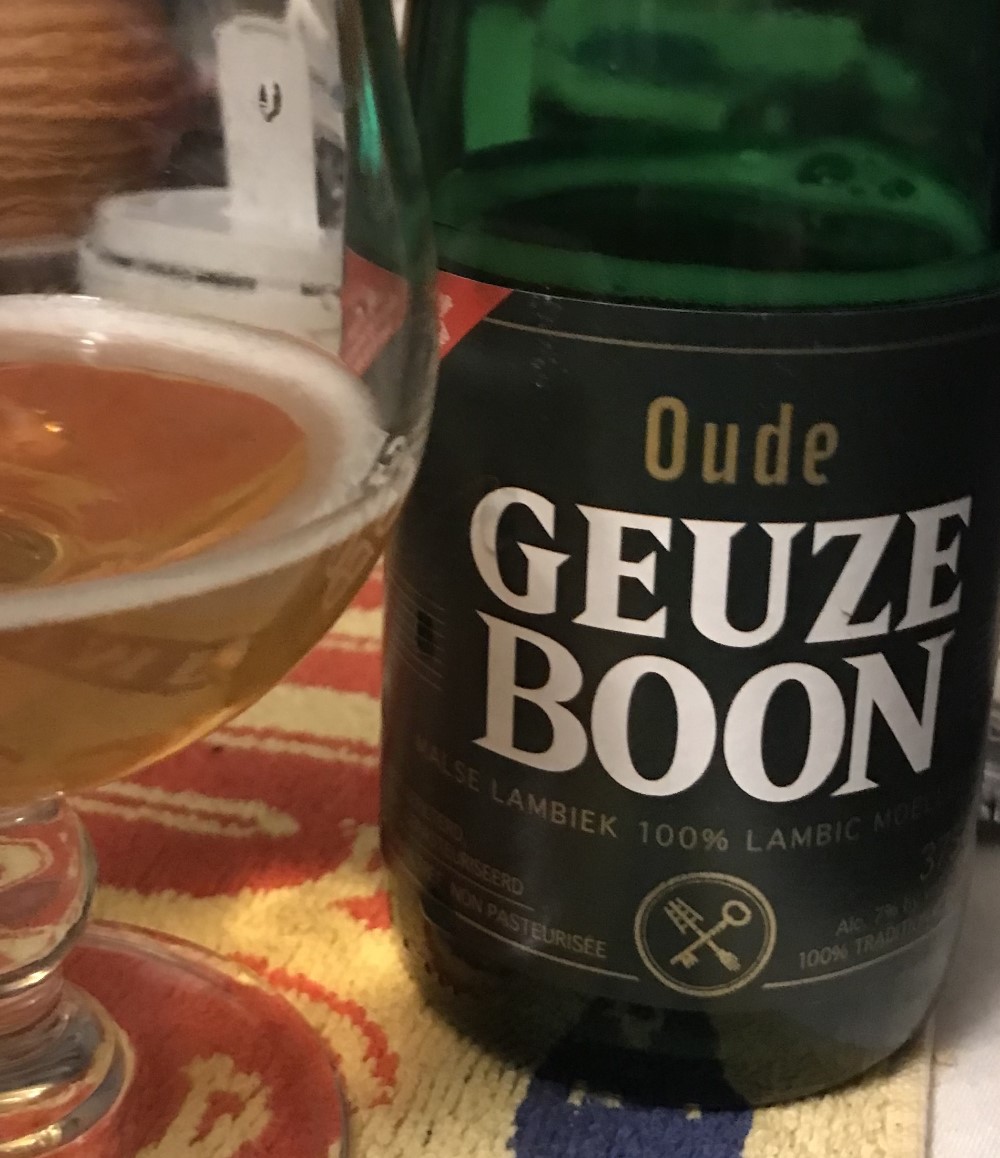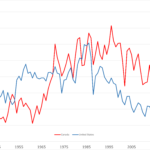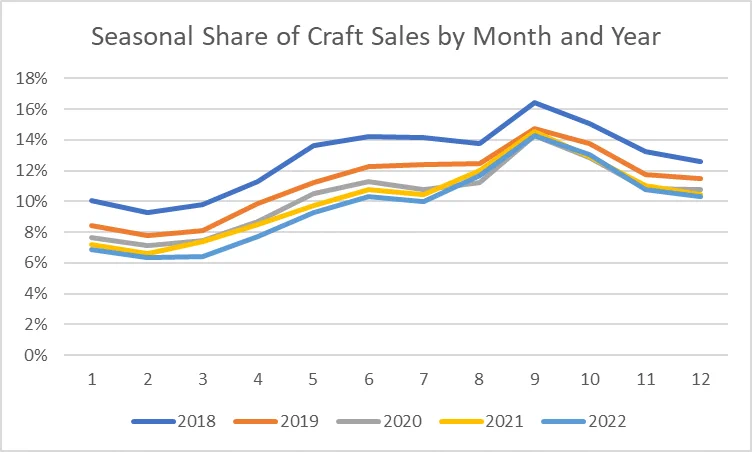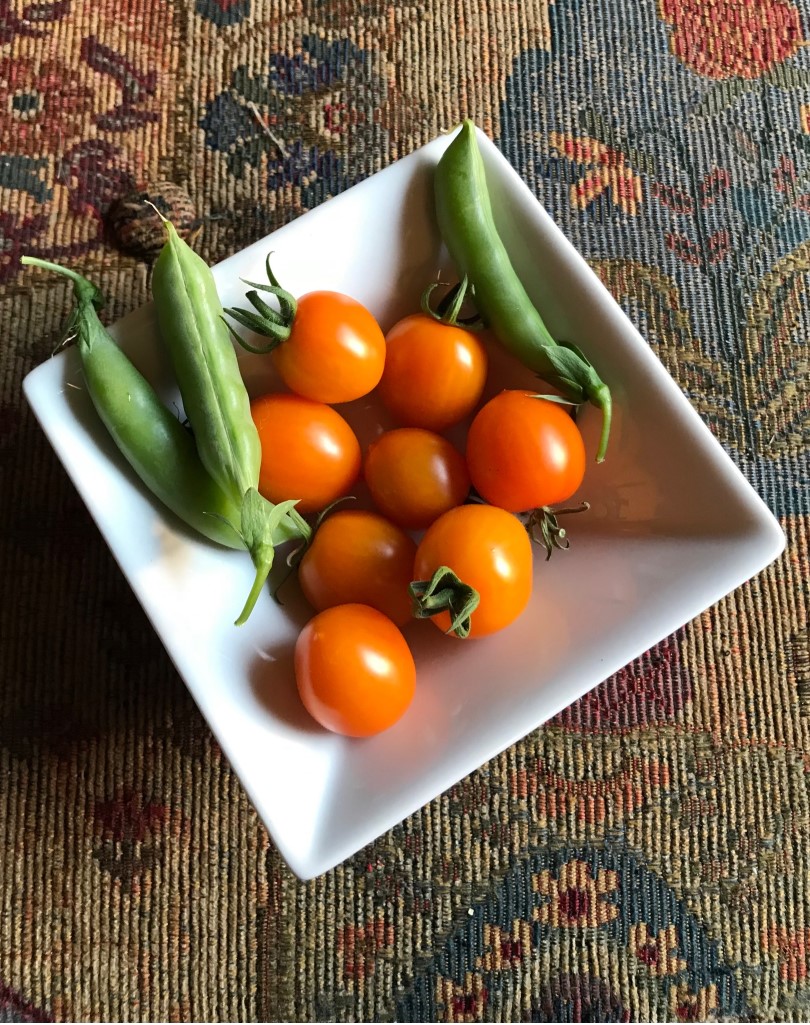 That’s that. Eleven months in the books. Tomorrow? The true Yuletide madness really begins. But before we get all holly jolly, the news in brews this week has not be uplifting. I was surprised last week how much positivity there was. As you will see below, this has not lingered if my reading is to be believed. Except if the British Guild of Beer Writers is to be believed as many of the awards presented last evening were won by familiar friends around these environs: David Jesudason for the treble including best book for sure but also Jessica Mason for business writing as well as Emmie Harrison-West including for communications about diversity and Eoghan Walsh for best self-published plus audio comms as illustrated. I knew them when. Err… read them when. All well deserved. And perhaps better than a silver cup… big congrats to Ruvani de Silva who got her story of the rise of foamy beer published in the lofty pages of the Washington Post:
That’s that. Eleven months in the books. Tomorrow? The true Yuletide madness really begins. But before we get all holly jolly, the news in brews this week has not be uplifting. I was surprised last week how much positivity there was. As you will see below, this has not lingered if my reading is to be believed. Except if the British Guild of Beer Writers is to be believed as many of the awards presented last evening were won by familiar friends around these environs: David Jesudason for the treble including best book for sure but also Jessica Mason for business writing as well as Emmie Harrison-West including for communications about diversity and Eoghan Walsh for best self-published plus audio comms as illustrated. I knew them when. Err… read them when. All well deserved. And perhaps better than a silver cup… big congrats to Ruvani de Silva who got her story of the rise of foamy beer published in the lofty pages of the Washington Post:
Foamy beer is a centuries-old European tradition, but in the American market the phenomenon has spread from a nerdy niche to a veritable tidal wave of foam-focused pours across the United States. Increasingly curious drinkers have put bad memories of sticking their fingers into Solo cups at college keg parties behind them and are seeking out the perfect pour, where the presence of beer foam enhances their drinking experience — aided by the arrival of Czech Lukr “side-pour” taps and a new interest in British-style cask engines.
That’s writing for real Bezos bucks, folks. Sweet. Now, remember those successes as we now get back down into the weekly grind. Starting with a question asked by the Morning Advertiser: where have all the pub guides gone… including one published previously by the UK‘s AA Limited, trading as The AA (formerly The Automobile Association)… the people with that nice mod yellow and black logo:
Before you shout “it’s all online now” – it isn’t. People think the AA do everything online but it still produces a book. It’s called The Restaurant Guide and the strapline is written by Janson Atherton, the Michelin-starred chef. So goodbye printed pub guide and hello Michelin man… restaurants ahead of pubs apparently.
The article somewhat confusingly traces the end of the Good Pub Guide which went from being an actual book to an online publication in 2009 and then ceased being updated there in 2021. They also note the loss of the Eating Out in Pubs book which Michelin had put out. Was that one last seen in 2018? Mudgie asks reasonably “is there a decline in the number of people interested in seeking out unfamiliar pubs?” while Matthew noted “I literally had a guide book about pubs published a month a go” as well as:
It also misses the point that the publishing industry has been decimated by both access to free stuff online and inflation making producing high quality print very expensive. This is the toughest I’ve ever known it as a freelancer, I don’t have enough work.
My only quibble is the comment on “free stuff” given paid online came and continues to come from bloggers (even those hiding in those difficult to access newsletters) some of whom decided to get into books and mags starting around 2010-12 and then a few of whom proclaimed themselves “beer experts”, a handful of whom actually are… in specific areas of expertise. We remember that access to audience does not necessarily denote quality in such matters. Consider this sort of made-up cleverness that is less than convincing. We remember too that audience is also no guarantee to reward. Consider now Pete‘s honest sharing this week of the realities of even someone who has voice a voice and topics as well as he has. So the reality is there has only been a living for a few in this area of scribbling. For many it is largely augmented by other income. Most do it for something between love and an itch. What, then, is the “free stuff” in this context I ask… with every sympathy. I do think about that when I read the names of all those shortlisted for last night’s awards.
To make matters even worse, to Matthew’s list I might have also added the sudden wave of crap A.I. generated shit and how (i) it is shit and (ii) how it undermines the expectations of readers, now realizing that some much of the text we encounter is too often A.I. generated shit. Imagine reading this, remembering I used to subscribed to Sports Illustrated. No wonder making a go of it is so hard. [Operative words being, of course, “used to”!] To be fair, I still get The New Yorker and Flagmaster,* international man of mystery that I am, both in physical format. So support those you like if you want to read their writing. And I think about this as well when I read the names of all those shortlisted for last night’s awards.
And yet… and yet… we have to be honest about how layering on that we see the UK bracing for the coming tide of Yule with some sobering… sober… semi-sobered stats out there for the trade, included in this article by James Evison in TDB:
– “the average Brit now drinks… only about 124 pints of beer, which is half the number of 50 years ago“;
– “a third of adults would avoid drinking at Christmas altogether“; and
– “more than half (56%) of 18-34 year olds looking to avoid alcohol over the festive period, compared to a quarter of those aged 55 and over.“
You know, especiallly listening to some blander beer boosting pundits, you would think that something apparently called neo-temperance is to blame and not just a case of folk either finding times tight, wanting to get healthier or finding fun things to do other than getting laced. Like flags, for example. They are fun. Or gardening. Hmm. See, even thought I try to find the uplifting stories for you, I am personally more inclined to sees this all as an overall shift. And a shift towards something else. In Canada as was illustrated neatly by Jason Foster of On Beer who issued some national stats, tracing the plateau and descent that brewing hereabout seems to be experiencing:
…the real story here is the negatives. Nine of 13 jurisdictions report a reduction in the number of breweries per capita (15+). Given that Quebec’s number was previously undereported, there likely isn’t much growth there either. Had I gone with the most recent population data from Q3 of 2023, things would have looked even worse (I didn’t because we can’t get an age breakdown for that dataset). The clear conclusion from this table is that the growth of craft beer has stalled and that with population growth this means the industry is actually starting to fall behind. We are seeing fewer breweries to serve the available market than we did a couple of years ago.
Again with Matthew, he hints at the same thing in the UK, that a reckoning is coming: “speaking to a lot of breweries, so many are up against the wire, even those who may appear on the surface to be thriving, behind the scenes it’s a different picture” so expect to see more exits in early 2024.** While entirely embracing the excellence of folk like Katie at The Glug,*** please ignore some of those “insta expert insider” newsletters while you are at it. There are some amazingly bad takes out there – still! – telling who ever will listen that this is just a blip in the manifest destiny of craft. Seems folk gotta stick to that script. Props gonna prop.
Bad takes and sometimes bad actors. As we see, given the facts as reported, in this simply inspirational if not somewhat defining subtly saucy take****:
Ultimately, Durstewitz says that to expand, Bevana Partners has to stand for quality and reliability in the eyes of wholesalers, retailers, and most importantly, drinkers. Bevana isn’t a household name now, but Durstewitz says the plan for next year is to create marketing materials like shelf talkers that direct shoppers to Bevana brands specifically, which may be grouped together on a shelf.
May. Be. Note to self: don’t jump into something about a decade late with no real plan other than being taker on the take. And of course, there are the tales of the workplace like this piece by Will Ziebell in The Crafty Pint on burnout in the small scale beer industry. It covers a lot of ground that has been explored before but, still, one wonders who has been writing all those not award winning brewery puff pieces and how (or why) they missed what was apparently right there all around them:
During his time in the industry, Tony says expectations around long hours and bad pay were so common that people would talk about it openly during industry events – and not just between sessions over a beer. “I used to go to the conferences and people would be onstage talking about how we’re in the industry because we love it and the pay is going to be shit with long hours,” he says. “That’s within a presentation experienced brewers are giving us, so it felt like we were being set up to put up with this stuff. You can only do that for so long.”
But… but still… even with all that, all the taking and not giving, there is still good stuff. Stuff worthy of awards or at least admiration. Utterly conversely to the above downpour of downers, Alistair wrote about his recent return to Prague where he once had had an extended residency (something like Cher in Vegas?). Upon his review and found a spot he knew:
…I could have stood there all afternoon just gazing at the city that for 10 years I called home, though this time tinged with melancholy. I was missing Mrs V, and the Malé Aličky, and promised myself that next time I come back to Prague, they will be coming with me. Several times as we strolled through the orchards on the side of the hill, I stopped and just listened, marvelling that such peace and quiet is still possible in a major European capital city. Coming off the hill at Ujezd I spied a brewery sign I hadn’t seen in many years, that of Primátor, and then noticed the sign behind it was for one of our old hangouts, Dobrá Trafika.
And then he wrote about the bar snacks, a favourite theme of mine: “…we had nakládaný hermelín, utopenec, and škvarková pomazánka, with classic Šumavský chleb to spread all the unctuous goodness onto.” No, I have no idea either but it sounds great.
Similarly, Martin found lovely scenes in London and published a photo essay worth checking out. And then he found a seat under an arch:
Two great staff (“Enjoy, my friend“), one cask beer, a 6% IPA that will be in my end of year awards. Cool, chewy, gorgeous (4.5). Proof you only need one cask beer on, just as someone once said. Bit quiet, but then it was 4pm and the mile only gets busy from late on Friday, but the rumble of trains above my head and the jazz soundtrack, at perfect volume, sealed the deal for me.
And Pellicle (as Pellicle does) published another interesting story, this week one by Tim Anderson on beer’s adjacent bev sake explaining both the subject and the experience of researching:
At first I’m afraid this might all go over my head, but Shōji and Momiki are both enthusiastic, good-humoured, and most of all, thorough guides. They take me on an in-depth, whirlwind tour of the entire sake-making process. We visit a sacred water source on top of a mountain, we meet the farmer who grows the rice, and the man who grows the kōji used to ferment it. With all of this presented to me, it becomes easier to understand how sake really can be imbued with meaning, and a sense of place that goes deeper than terroir.
See, that’s good stuff. And there’s gotta be more to read that’s not just a grim reminder. Let’s see what’s out there. Jeff left his notes on the plane. Which is a drag sure but it’s not without, you know, being the cause of a shamelessly cheeky and perhaps even insolent rise of an eyebrow:
I arrived at Portland International Airport last night at 11pm, or 2am on the East Coast time to which my body is currently adjusted. I immediately deplaned, leaving my coat with the notes to brewery tours at Jack’s Abby and Sacred Profane tucked in a pocket. By the time I realized the error and returned, efficient Alaska employees had already buttoned up the gate and departed. All of this is a preamble to today’s rare post of newsy bits—and why I’m outsourcing content today. While I wait with fingers crossed to see if the coat comes back to me, let’s chew on these items.
Come back, Jeff’s coat, come back! That’d be good if it did. And places for beer are still opening like Iron Hat in Alberta, like Recluse Brew Works in Washougal, Washington – and like the new beer spa in Sykesville, MD called BierBath and… and… a place in San Francisco called Otherwise Brewing planning to sell only gluten free beer. So it’s still churning along. And beer is cheap at beaches in Turkey. Don’t forget that. And Mr. Protz joined in on the articles on Dark Star’s version of Prize Old Ale adding plenty of detail:
The beer is astonishingly complex. It pours a deep russet brown with a dense collar of foam. The aroma is dominated by a musty note brewers call “horse blanket” with notes of burnt raisin and sultana fruit, wholemeal biscuits, spice and pepper from the hops, with touches of bitter chocolate, espresso coffee, liquorice and butterscotch. The palate has creamy malt, burnt fruit, spicy hops, coffee, butterscotch, liquorice and acidic notes. The finish is bittersweet with sour fruit, peppery hops, chocolate, coffee and butterscotch with a dry and acidic finale.
Holy gambolling gums! Lots going on there in the theatre of that particular maw. All good.
Yet… yet… and yet… the freshly award winning Jessica Mason has opened my mind scientifically speaking to an entirely new branch of concern with this startling health related news:
…there are multiple documented instances in which children diagnosed with fetal alcohol syndrome were born to mothers who denied that they consumed alcohol during pregnancy… The studies ultimately concluded that chronic male alcohol exposure – defined as consuming more than five drinks per day in a four-hour window – could create the core fetal alcohol syndrome birth defects.
Really? That’s a lot to take in. What’s next? Well, if only go by these stories in chronoligical order (and entirely for Stan) this is what is next: “‘My dog is drunk’ … owner discovers her dog has hit the bottle.”
Fin. We are done. I know I’m done. When you get to the drunk doggie story, you have to be done. Remember, ye who read this far down to see if I have edited these closing credits and endnotes (as I always do), you can check out the many ways to find good reading about beer and similar stuff via any number of social media and other forms of comms connections. This week’s update on my emotional rankings? Facebook still in first (given especially as it is focused on my 300 closest friends and family) then we have BlueSky (90) rising up to maybe pass Mastodon (906) then the seemingly doomed trashy Twex (4,427) hovering somewhere above or around my largely ignored Instagram (159), with unexpectly crap Threads (43) and not at all unexpectedly bad Substack Notes (1) really dragging up the rear – and that deservedly dormant Patreon presence of mine just sitting there. All in all I still am rooting for the voices on the elephantine Mastodon but BlueSky is catching up. And even though it is #Gardening Mastodon that still wins over there, here are a few of the folk there discussing beer:
Alan McLeod | A Good Beer Blog (… me…)
Stan Hieronymus | The Man!
Boak & Bailey | The B² experience
Curmudgeon Ale Works | Jonathon is Brewing
Katie Mather | Shiny Biscuit and Corto
David Jesudason | “Desi Pubs” (2023) author
BeoirFest | They say “Let’s Talk Beer”
Ron Pattinson | The RonAlongAThon Himself
Al Reece AKA Velky Al | Fuggled
Jennifer Jordan | US hops historian
Andreas Krennmair | Vienna beer and lager historian
Beer Ladies Podcast | Lisa Grimm and colleagues
The Bar Towel | Toronto’s chat zone for beer lovers
Chicago Beer Society | Folk in Chicago getting social over beer
Jay Brooks | Brookston Beer Bulletin
Joe Stange | Belgian beer expert, beer magazine editor
Cider Bar | Barry makes Kertelreiter cider
Laura Hadland | CAMRA historian and beer writer
Brian Alberts | US beer historian
Jon Abernathy | The Beer Site
Maureen Ogle | US Beer Historian
Lars Garshol | Norwegian Beer Historian and Kveik Hunter
James Beeson | Beeson on Beer
Carla Jean | MAINER!!!
Thandi Guilherme | Beer Ladies Podcast Co-host
Lisa Grimm | Beer Ladies Podcast Co-host
Roy of Quare Swally | Beery ramblings from Northern Ireland
Rob Talksbeer | Podcaster and Youtuber
Anthony Gladman | UK Drinks Writer
Jeff Alworth | Manna Of Beervana
Northwest Beer Guide | Fairly self explanatory… but not NW Latvia…
Evan Rail | Prague based GBH editor, freelance writer, NYT etc.
Todd Alström | 50% of the Alströms
Jacob Berg | Beer talking librarian
Anyone else? Anywhere else? Yes, you also gotta check the blogs, podcasts (really? barely!) and even newsletters to stay on top of things including the proud and public and certainly more weekly recommendations from Boak and Bailey every Saturday and Stan at his spot on those Mondays when he is not SLACKING OFF! Look at me – I forgot to link to Lew’s podcast. Fixed. Get your emailed issue of Episodes of my Pub Life by this year’s model citizen David Jesudason on the odd Fridays. And Phil Mellows is at the BritishBeerBreaks. Once a month, Will Hawkes issues his London Beer City newsletter and do sign up for Katie’s now much less occassional but always wonderful newsletter, The Gulp, too. Ben’s Beer and Badword is back with all the sweary Mary he can think of! And check out the Atlantic Canada Beer Blog‘s weekly roundup. There is new reading at The Glass. Any more? Yes! Check to see the highly recommended Beer Ladies Podcast. That’s quite good. And the long standing Beervana podcast . There is the Boys Are From Märzen podcast too and Ontario’s own A Quick Beer. There is more from DaftAboutCraft‘s podcast, too. All About Beer has introduced a podcast… but also seems to be losing steam. And there’s also The Perfect Pour. Plus follow the venerable Full Pint podcast. And the Craft Beer Channel on Youtube and remember BeerEdge, too, and The Moon Under Water… if you have $10 a month for this sort of thing… I don’t. Pete Brown’s costs a fifth of that. There was also the Beer O’clock Show but that was gone after a ten year run but returned renewed and here is the link!
*No, you are!… you’re a big dopey loser with weird hobbies… I’m not… I’m not… quit it… stop.
**The medium may be the message but the messages may vary, too. Just look at this week‘s pointed poke at my font of jealousy from Katie: “We were exceptionally lucky—there was one free table. This never happens, I’m sure. We sat down with our almost-finished pints and ordered a roast dinner and a huge plate of venison stew.”
***Yet in Dorset a “brewery in Peaceful Lane will replace a dilapidated chicken coop” defying all the odds after agreeing to no tap room and no on-site sales.
****And those insta-update about the lawsuits are pure gold!
















